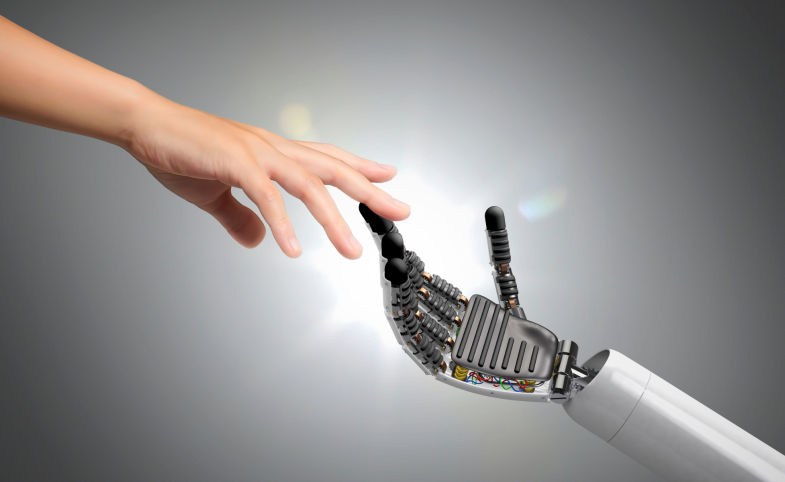The CPD Blog is intended to stimulate dialog among scholars and practitioners from around the world in the public diplomacy sphere. The opinions represented here are the authors' own and do not necessarily reflect CPD's views. For blogger guidelines, click here.

The Robot Diplomat: Can AI Build Peace or Just Code It?
Living in the capital, Washington, D.C. has its own kind of charm. The city hums with the rhythm of policy debates and global summits, where conversations about the world’s future take place every day. Lately, with the rapid rise of artificial intelligence, Washington, D.C. has become a gathering place for technologists, entrepreneurs, academics, and policymakers who are drawn together by AI expos, conferences, and discussions about where this technology is leading us.
It’s one of the things I love most about this town: the constant exchange of ideas. You meet people from every professional background, each bringing a different lens to the conversation about emerging technologies. Some are wide-eyed optimists, convinced we’re on the brink of a new golden age of innovation. Others are more cautious, voicing dystopian fears about machines outpacing human control. And then there are the pragmatists, the ones who stand somewhere in between trying to find a balance between embracing technology’s potential and preserving what makes us fundamentally human.
I sometimes call myself a “digital migrant.” I wasn’t born with an iPad in hand, but like many of my generation, I’ve crossed the border into the digital era learning, adapting, and sometimes stumbling my way through it. In that sense, I’m somehow newcomer to the world of artificial intelligence, still trying to understand its languages and its logic. In this, I find myself oddly aligned with late Henry Kissinger, who once reflected:
“Artificial intelligence is out of the box so we cannot argue about it as if we have an opportunity to abolish it. We have an opportunity to look at some specific dangers that it may present and deal with that. But the world will now be an artificial intelligence-assisted world.”
Kissinger’s words capture something essential about where we stand today. Artificial intelligence is no longer a speculative idea; it has become an irreversible reality. So, the question is no longer whether we should accept it, but how we choose to collaborate with machines, not in competition, but as a partner to find deeper mysteries of the human world.
But what does such human–machine collaboration actually look like? How does this partnership between humans and technology take form beyond theory and imagination? These are not abstract queries; they surface almost daily in my classes, where students are eager to understand the new relationships, they are already beginning to form with intelligent machines.
To learn more from the brilliant minds behind these machines, I decided to bring one into my classroom, a computer science researcher, Prof. Aref Zahed who leads an AI and robotic initiative focused on developing advance technology solutions. Soon, he introduced us to his invention: a humanlike robot named Iris. My students and I were blown away, as she turned her head, responded with clarity, and even smiled with subtle precision. It was astonishing experience with what I can only describe as an anthropic reality, where humanity and technology seemed to merge and collaborate. She wasn’t just a machine; she carried herself with an uncanny grace, a flicker of human presence that made us all pause. Iris could draft letters and grant proposals, answer complex research questions, and even code in multiple programming languages.
Intriguing, isn’t it? While codes and algorithms can solve problems beyond human capacity, they also introduce new challenges, yet within those challenges lie new opportunities.
From human–machine relations to international relations, how will this emerging partnership between humans and intelligent systems reshape the theory and practice of diplomacy, negotiation, mediation, and global dialogue? Will this partnership deepen cross-border understanding, or will it risk reducing the subtle art of diplomacy to a mere exchange of data, algorithms, and calculated logic?
"Robots might mediate disputes over resources or climate policy with impartial accuracy, while humans interpret the emotional undercurrents, the trust, hesitation, and hope that no algorithm can fully quantify."
A glimpse of this possible future is already before us. Take, for instance, the iconic figure of Sophia, the humanoid robot developed by Hanson Robotics, who captured global attention when Saudi Arabia granted her citizenship in 2017, making her the first robot in history to receive such recognition. She quickly evolved from a technological curiosity into a cultural and diplomatic phenomenon addressing the United Nations and appearing in international interviews. Sophia was often treated not merely as a machine, but as a symbol of human creativity and ambition, a bridge between technological imagination and the world of global diplomacy.
However, to flip the coin and look at the other side, Sophia’s role as a “diplomat” was less about policy and more about performance, a symbolic act that revealed how nations use technology as an instrument of soft power. When Saudi Arabia granted her citizenship, it wasn’t extending rights to a robot; it was sending a message to the world: We are embracing the future. In this sense, Sophia functioned as a techno-diplomatic envoy, projecting an image of innovation, progress, and a nation eager to lead in an AI-driven world.
Yet, Sophia’s diplomacy also raises deeper questions about authenticity and agency as: What happens when the tools of diplomacy themselves begin to possess a form of agency, however simulated? If a robot can represent a nation or a vision of modernity, does it also start to redefine the very nature of international representation and legitimacy?
As diplomats traditionally embody human judgment, empathy, and moral responsibility qualities rooted in lived experience. Sophia, by contrast, operates through scripted algorithms, her “empathy” a programmed illusion. Still, her presence challenges our assumptions about who gets to represent a nation, an idea, or even humanity itself.
In this way, Sophia’s diplomacy is both provocative and paradoxical. She is a diplomat without a state, a citizen without consciousness, and yet a figure that successfully draws the world into conversations about ethics, personhood, and the role of AI in governance. Sophia’s true diplomatic achievement may not lie in negotiation or policy, but in her ability to make us question what it means to be human in a world increasingly shared with machines.
I sometimes try to imagine what the world of robotic diplomacy might look like. Picture a grand hall of the future gleaming, minimalist, and alive with quiet hums of intelligent systems. Alongside human diplomats, humanoid robots and AI-driven envoys sit at the negotiation table, translating dozens of languages in real time, analyzing historical patterns, and simulating potential outcomes before a treaty is even signed. Their faces are calm, their voices precise, their logic unclouded by emotion, yet every word they speak carries the trace of human intention coded within them.
In this imagined world, diplomacy becomes a collaboration of intuition and computation. Robots might mediate disputes over resources or climate policy with impartial accuracy, while humans interpret the emotional undercurrents, the trust, hesitation, and hope that no algorithm can fully quantify. The future conference rooms of Geneva or New York may well have AI chairs assisting dialogue, generating consensus maps, or reminding delegates of ethical boundaries forgotten in the heat of politics.
This vision is not as distant as it seems. NPR reported, at the Center for Strategic and International Studies (CSIS) in Washington, D.C., the Futures Lab is already exploring ways to employ artificial intelligence to transform the practice of diplomacy experimenting with data-driven decision systems, predictive modeling, and AI-assisted policy simulations. What once belonged to the realm of science fiction is now taking shape in research labs and policy think tanks, signaling that the future of statecraft may soon include both human strategists and their digital counterparts.
One question would loom large: who will define the role of these machines, humans, or the machines themselves, once they possess the ability to code and refine their own intelligence? It’s difficult to predict with certainty, but one thing feels inevitable: the next era of diplomacy will be shaped not only by humans, but also by machines that speak our language perhaps even through a hybrid form of AI diplomacy, where artificial intelligence becomes both partner and participant in the global relations.
Visit CPD's Online Library
Explore CPD's vast online database featuring the latest books, articles, speeches and information on international organizations dedicated to public diplomacy.
POPULAR ARTICLES
-
November 3
-
November 5
-
November 13
-
November 25
-
December 17
Join the Conversation
Interested in contributing to the CPD Blog? We welcome your posts. Read our guidelines and find out how you can submit blogs and photo essays >.









